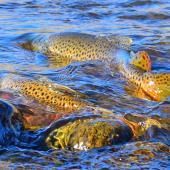High and Mighty
Wetting a line in Montana's alpine.
Hundreds of high-country lakes dot the mountains of southwest Montana, but accessing them often requires some dedicated planning and grueling legwork. Why fish up there when you could drive your boat to the put-in? Elbow room, clean air, amazing views, and spectacular fishing, that’s why. These alpine fisheries are nestled in some of the most beautiful and secluded places, places where anglers can catch large and pristine native cutthroat trout, rare and challenging golden trout, rip-snorting rainbows, and gorgeous grayling.
Montana FWP stocks many alpine lakes every four years, but some have populations of wild fish. The season is short at these highland tarns, ranging from late May through October for lakes around 7,000 feet in elevation, and July through September for the highest lakes. These brief windows of opportunity make for truly memorable fishing.
Absaroka-Beartooths
The Beartooths alone have over 300 trout-filled lakes––some of which hold 20-plus-inch cuttys and multi-pound golden trout. Because of this, the Absaroka-Beartooths are likely the most popular mountains for alpine anglers in our area. Multi-day trips are the norm. Lightning Lake, a notoriously difficult lake to access, is known as one of the best golden-trout fisheries in the Rocky Mountains. Mystic and Aero lakes are also popular.
Crazies
Despite limited access, the Crazy Mountains are a locals’ favorite for alpine fishing. Landowner relations have been strained here recently, and the appearance of trail closures, along with antagonistic signage, can be a deterrent for anglers. But if you find an open trail, you’ll likely find a sparkling, under-fished cirque lake at the end. Cave Lake is a popular but difficult-to-access destination for large golden trout. Blue and Pear lakes also offer good fishing.
Gallatin Range
Largely roadless and untouched, the Gallatins run north to south from the Gallatin Valley to Yellowstone National Park, between Gallatin Canyon and Paradise Valley. Hyalite Reservoir, one of the most popular recreation areas in Montana, holds brook and cutthroat trout, as well as large arctic grayling. Rat Lake, made famous by author John Geirach, is accessible by a short hike. The Hidden Lakes and Golden Trout Lakes offer easy access to golden trout, and beautiful Ramshorn Lake holds nice-sized cutthroat.
Madison Range
On the west side of Gallatin Canyon is the Madison Range, broken up by the community of Big Sky. North of Big Sky lie the Spanish Peaks, which host a number of fishy lakes, including the well-trafficked Lava Lake. The southern end of the range is home to the Hilgard Basin, which possesses over a dozen fishable lakes.
Tobacco Roots
The Tobacco Roots are more accessible by motor vehicle than the other ranges mentioned. Many old mining and logging roads, while rugged, are open for adventurous motorists. The South Boulder River drainage hosts a good number of fishy lakes, as do the Willow Creek and Meadow Creek drainages.
Pioneers
A sibling range to the Tobacco Roots, the Pioneer Mountains (between Dillon and Butte) contain many beautiful and accessible alpine lakes. Many of these lakes are remnant or still-used irrigation impoundments. Look to the east slope of the East Pioneers for some of the prettiest and fish-abundant mountain lakes in the region.
Stocked Waters
Montana FWP does not stock rivers or streams with trout, with the exception of a few native-fish restoration projects. In the 1970s, it was determined that these fisheries thrive when left alone.
Lakes are another story. Both lowland reservoirs and mountain lakes are regularly stocked by the state. Reservoirs like Canyon Ferry and Willow Creek (Harrison Lake) regularly receive thousands––sometimes tens of thousands––of planted trout, many of which grow enormous.
Most stocked alpine lakes get plants of two-inch cutthroat trout, every four years. Try fishing these ponds four to six years after a stocking to hit the largest fish. In special cases, FWP will stock non-native fish like golden or rainbow trout in mountain lakes.
There are also a few kids’ ponds scattered throughout the region that receive catchable (eight- to ten-inch) trout and even a few brood-stock behemoths to get the youngsters excited about fishing. A list of every stocked lake and waterway––as well as information concerning size, species, and quantity of fish stocked––can be found at fwp.mt.gov/fish/stocking.html.—Joshua Bergan











